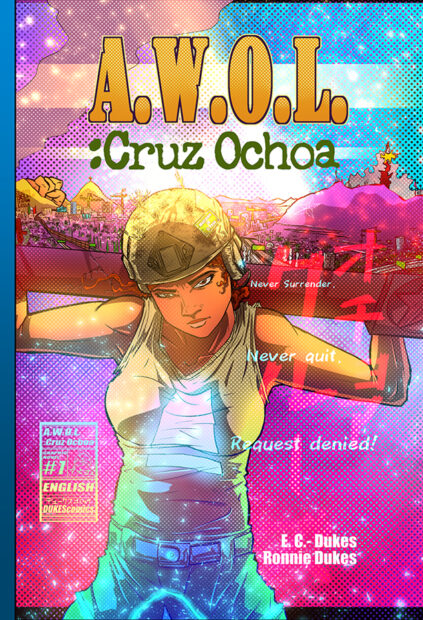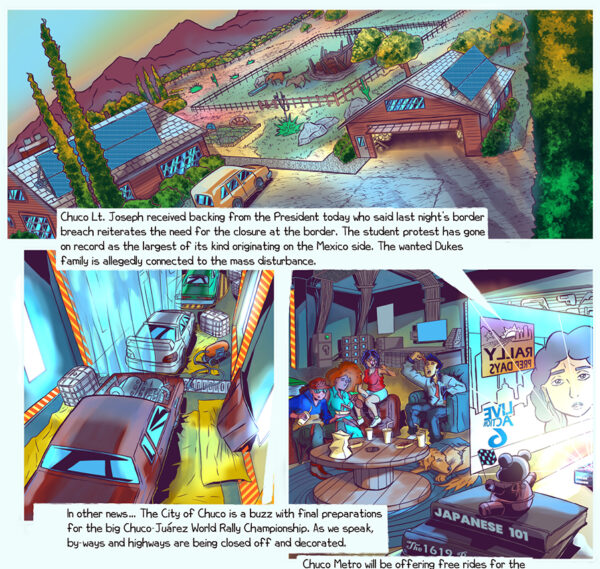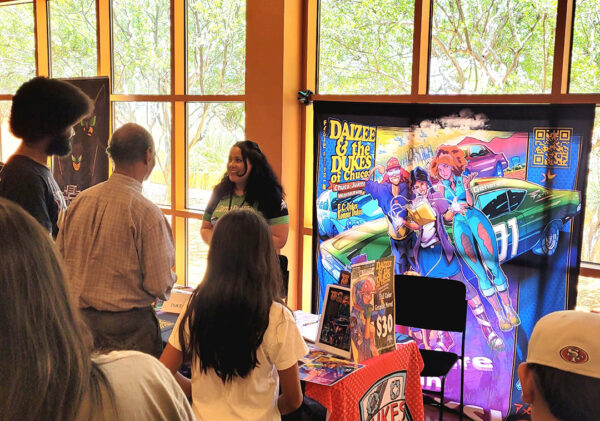Earlier this year, I had the opportunity to speak on a panel at the El Paso Museum of Art (EPMA) alongside other women of color working in the arts. It was an honor to be invited and was a chance to see a part of the state I had not previously visited, but most importantly, it was rewarding to meet and learn about other women arts professionals. The other panelists included Sereka Barlow, EPMA Foundation Board Chair and Chief Executive Officer of YWCA El Paso del Norte Region; Sheetal Prajapati, an arts professional and Principal & Founder of Lohar Projects, an art and culture advising agency; and Dr. Elvira Carrizal-Dukes (E.C. Dukes), one of the creative forces behind DUKEScomics, and a filmmaker, writer, director, and producer.
What’s interesting about participating on a panel like this is that although we had virtual meetings prior to the event, we really got to know each other in the moment, during the panel, and at lunch afterward. I enjoyed hearing about Mrs. Barlow’s nontraditional path to arts advocacy and becoming the Board Chair of the EPMA Foundation, and I deeply understood the experiences that led Ms. Prajapati to step away from working at institutions like the Museum of Modern Art to found her own consulting firm. But, I think I was most surprised by Mrs. Dukes’ story of taking her love for filmmaking and translating it into the more affordable and realistic route of comics and graphic novels.
Mrs. Dukes and her husband, Ronnie, launched DUKEScomics in 2017 with their first graphic novel, A.W.O.L.: Cruz Ochoa. I recently spoke with the couple about their work.
Jessica Fuentes (JF): Tell me a little about how DUKEScomics came to be. When did you launch it? What is the company’s goal? Who is behind it? What are your roles?
E.C. and Ronnie Dukes (Dukes): We met at the University of Minnesota-Twin Cities as undergrads. E.C. is from Chaparral, New Mexico, and Ronnie is from Chicago, IL. We moved to NYC, where E.C. earned an MFA in film directing at Columbia University. This is also the city where we got married in 2006.
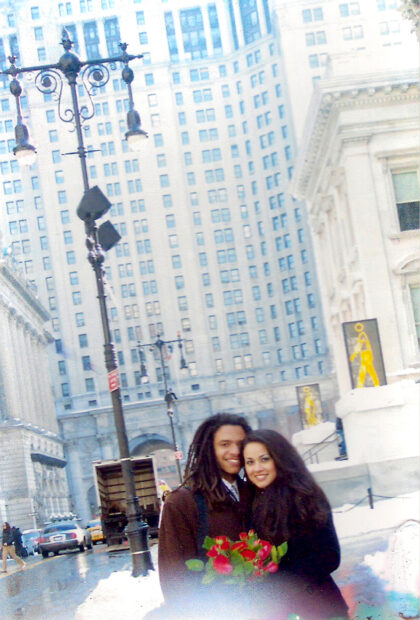
Ronnie and Elvira Dukes in NYC, following their marriage at the Manhattan courthouse on February 14, 2006.
DUKEScomics came to be after years of working independently as individual artists. E.C. was attempting to make a military-themed adventure feature film and Ronnie was an exhibiting painter in Harlem. We decided to join forces and mix E.C.’s writing with Ronnie’s art in a graphic novel form.
DUKES is Ronnie’s actual last name and E.C.’s married last name, which is why the business is called DUKEScomics. We launched DUKEScomics in 2017, when we released our first graphic novel, called A.W.O.L.: Cruz Ochoa, written by E.C. and featuring art by Ronnie. E.C. is the writer and Chief Executive Officer of the company and Ronnie is the artist and Chief Creative Officer. We became an official LLC in New Mexico, E.C.’s home state, in 2023. The goal is to publish and present a view for the future that is positive and will inspire change.
JF: Both of you have varied backgrounds. How do your past professional, educational, and artistic experiences shape the work you do now?
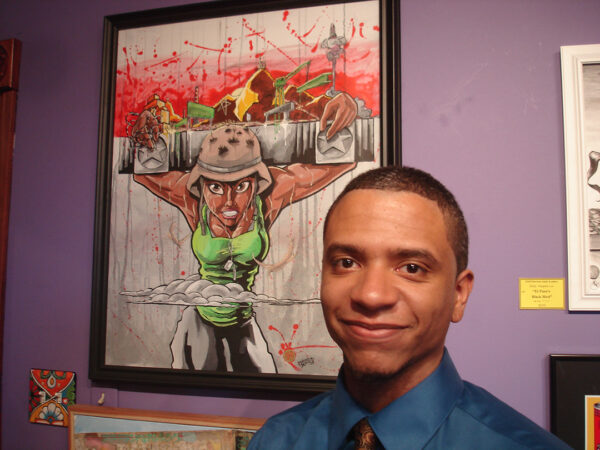
Ronnie Dukes standing next to one of his paintings, which would later inspire the cover of “A.W.O.L.: Cruz Ochoa.”
Dukes: Ronnie’s animation education greatly influences the way he sees shapes and visuals, which he says made him a better artist overall. He started painting and exhibiting and from there went to comic books. Early on in Minnesota he did a lot of work with the university, as far as working with different community organizations that needed outreach materials like posters and pamphlets. This experience impacted the type of work Ronnie wants to do as far as working with the community and using his artwork for good. Even to this day DUKEScomics still works with universities writing and creating comics for researchers and healthcare workers, as well as organizations such as the Alzheimer’s Association West Texas Chapter. We also work with the EPMA not only doing creative work, but also as teaching artists, to pass on our knowledge to the next generation of young artists in the El Paso area.
E.C.’s education has prepared her for being a strong writer. Her BA degree is in Journalism and Chicano Studies, with a minor in Theatre Arts. This background helps her communicate in a concise manner that comes in handy in our current work and helps her write stories from a multicultural and historical perspective. The theatrical training has inspired her creativity. E.C.’s MFA taught her screenwriting and how to create visual stories through storyboards, as well as how to work with actors. E.C. brings this experience into our current comics and graphic novels that we’re working on. She’s able to see things from a cinematic perspective.

A still image from E.C. Dukes’ short film “Mariposa,” a movie adaptation of her play “Escaping Juarez.”
E.C.’s Ph.D. in Rhetoric and Composition has brought another genre of writing, which is academic research and scholarship. As a result, DUKEScomics is engaged in producing Graphic Medicine, which is an academic term used to denote the use of comics in medical education and patient care. This year we wrote and created several comics on various healthcare issues, such as caregiving for patients with Alzheimer’s or other dementias, Latina brain health, HPV vaccine awareness, and Trauma-Informed Care. We have also co-authored academic articles about this work, such as Bilingual Comics on the Border as Graphic Medicine: Journaling and Doodling for Dementia Caregiving during the COVID-19 Pandemic for the Community Literacy Journal.
JF: What do you enjoy most about the medium of comics and graphic novels? What does it offer that other mediums do not?
Dukes: For Ronnie, comics and graphic novels are relative to something he feels close to, and within his skill set as an illustrator and artist. Ronnie has always been an artist, and comics and graphic novels were an awesome way to see how someone else expressed their art and themselves and told a great story. They were really entertaining and made Ronnie want to read the next thing. They are inspirational in that way. As far as what the medium offers, it allows Ronnie to visualize worlds that he otherwise would not be able to communicate to other people.
What E.C. enjoys the most about comics and graphic novels is being able to tell a story in a cinematic way. It’s almost like watching a film while you’re reading. You can also go at your own pace. You can stop and go back and pick it up again; you can go backwards or forward at any point. You read the comic at your own leisure. You create your own reading experience. At the same time, your brain is working on many cognitive levels. Not only are you reading and practicing literacy, but your brain is also interpreting the visual images you’re seeing while you’re reading. You’re putting text and image together to make meaning.
In comics you can stay on a frame for a very long time and study it and just enjoy it and take in all of the details. And then you can go backwards and compare it to something else you saw. And then go back and sit on that frame again. And just enjoy it. But with a film, when was the last time you pressed pause and just watched a frame in a film and then rewound and looked at another frame in the film? With comics you can appreciate every frame and really compartmentalize for the colors, the framing, so many different things that make it a unique medium.
We also love how comics and graphic novels allow for any genre of story and any style of art making, any style of illustration, any voice, and any perspective. There’s room for everything. There are really no rules. We love how much diversity there is, and you never get bored because there’s always something new in comics, especially if you follow independent comics.
JF: What is it like to collaborate with your partner? What are the joys and the challenges?
E.C.: For me, it’s an honor and a privilege because I’m not an illustrator, I’m not a trained visual artist. I’m a writer. I have the benefit of working with someone who is brilliant in illustration and art. And who can, from my experience working with him for over 20 years, draw anything. And he can make it even better than what you imagined. It’s great to have a proximity between the writer and the artist. And to be able to peek over each other’s shoulder at any time and ask each other questions to get some feedback along the way is helpful.
The joy is that we are in this together. We are both passionate about creative industries that fit well together. We don’t feel like we’re alone in this. We have each other, we’re a team.
Ronnie: E.C. and I have worked together since undergrad where we were members of the same organizations, and I would use my art for posters and flyers. I also served as E.C.’s Artistic Director on her award-winning play, Father’s Shadow/ Sombra del Padre, which was published by Dramatic Publishing, while we were students in Minnesota. We’ve always worked well together and I always just wanted to be near her. So that’s what’s good about how things are now: we get to work together, and we work well together. I love spending time with her, and I always have.
A challenge is that because we both come from art and creative backgrounds, all of the things about being a business are things we are discovering together, at the same time. So, the challenge is a welcome challenge, where we are learning the business of being a business and thriving at it as well. We are taking on more commissions now and our business has evolved from just creating comics that we write and produce. We’re now envisioning other people’s projects on a larger scale as we grow professionally.
JF: How are the stories Dukes Comics creates different from what else is available in the world of comics and graphic novels? What sets you apart? Who is your audience? How is what you make relevant?
Dukes: Our work features the U.S. Southwest with strong female BIPOC protagonists and characters. We feature multicultural, multilingual, various shades of brown-skinned characters in a futuristic urban setting. Our new graphic novel Daizee & the DUKES of Chuco: Chuco-Juárez is speculative fiction — it’s Fast and Furious mixed with cyber punk. We feature the U.S./Mexico borderland cities where we live: Chaparral, El Paso, and Juárez, Chihuahua. There’s not a lot of graphic novels that feature our part of the world. E.C. is a Xicana writer, Ronnie is a Black artist, and all of our work is original and created by us.
We produce graphic novels over 90 pages long in full color and in multiple languages. Our work has been distributed internationally in Japan, Germany, and soon, Mexico. Our graphic novels are also in local libraries. We feature military, environmental, and sci-fi themes. Our audience is people ages ten and up and anyone who likes fast adventures, BIPOC characters, a Southwestern environment, cars, environmental topics, Chicanofuturism, and people who support Black and Chicanx writers and artists. What we make is relevant because we incorporate real-life themes that impact society, such as the use of fossil fuels, the overpopulation of cars on the road, and climate change.
In our current book, our lead character Daizee invents a device to make vehicles non-dependent on fossil fuels. Daizee and her cousins are being targeted and criminalized by the police and corrupt oil and gas industry henchmen who see her invention as a threat to their profits. They threaten the lives of Daizee and her family. There’s opposition to solving the climate crisis. It’s a real-life antagonist that is also a character in our book.
We love to research technological innovations, so there are futuristic elements in our book based on technology that is currently being developed and on the verge of being available soon. Our story’s city, Chuco, is set in the future, and we incorporate the city’s real-life future plans for parks and buildings. When you read Daizee & the DUKES of Chuco you’re seeing El Paso in a real tomorrow form. We included a park that is in the plans for the future of our city. There are several streets that go across the highway in the downtown area, and instead of them, the plans are to build a large Central Park-style area that covers the highway, putting it in a tunnel under the park. Like how Soldier Field in Chicago put their highway underground in the same area around museums in Chicago to make more walkable, livable space for pedestrians and residents. We hope to inspire the next generation to take the next step for a lot of city environmental development. El Paso is home of Gene Roddenberry, and we’re huge fans of Star Trek: The Next Generation. We want to take up that mantle to inspire the way Gene inspired innovations such as the cellphone.
A month after we published Daizee & the DUKES of Chuco we read national news that nuclear fusion had been achieved; this technology is in our book. We were hoping that this would be achieved. In our book it’s more consumer-ready. The antagonist’s goal in our story is to destroy Daizee’s invention. This is how we’re relevant: we research what is happening in our world and we incorporate it into our stories to create a world that you really will see in the future.
JF: You were recently in Dallas for Texas Latino Comic Con. Was this your first time participating in the event? Tell me about the event, what it was like, and what the reception was like for your work.
Dukes: Our professional experience in comics and graphic novels has included traveling and exhibiting internationally at shows such as Tokyo Comic Con, Leipzig Book Fair in Germany, and soon the Guadalajara Book Fair in Mexico. This professional experience has put us in the same room with the pros and the veteranos, such as at Texas Latino Comic Con. We are honored to be exhibiting alongside creators who have been doing it for over twenty years. We’re the new kids on the block, but we come with a lot of heart and experience and with two graphic novels we’ve created ourselves, published, and toured. Our graphic novels are also in multiple languages – English, Spanish, Japanese, and German.
This was our first time at Texas Latino Comic Con. The event was so much fun. The theme was Lucha Libre. Many people who attended the event wore various Lucha shirts. There was a lot of excitement amongst families and young people. The Lucha match in a Black Box Theatre [a program organized by the event] made it even more spectacular. It felt like a surreal world. The audience participated in the performance just by being spectators and booing and clapping and laughing. It felt like watching a live action comic book. There were characters, protagonists, and antagonists. There was conflict, a climax, and resolution. Exhibiting in the Plaza de Creativos, we felt like we were amongst legends like Richard Dominguez, Rafael Navarro, Hector Rodriguez III, Veronique Medrano, Henry Barajas, and David Bowles. They’ve been at this for a long time. Dominguez celebrated the 25th anniversary of the El Gato Negro a few years ago. Meaning, his first comic con was over 25 years ago! In total, we have had a good 2-3 solid years attending comic cons. We’re fairly new in the game. You must have passion, commitment, discipline, and love for your art and enthusiasm in order to last for so long.
To see these creators still doing their craft after so many years was inspiring. They shared their experience and knowledge. It was a fun event at the Latino Cultural Center in Dallas. The people of Dallas who stopped at our table were great, and they seemed to really love our book; they lit up when we started talking about the story. When we start talking about the story to different people in various cities, their excitement builds and they can’t wait to get home and read it. Our ideas are appealing to them. It was a great reception. Thank you, Dallas.
JF: What’s next for Dukes Comics? What are you working on? Where will you be traveling next?
Dukes: A new look. We’re going to dive into new genres, some a lot darker than what we’ve done in the past. We have two new DUKEScomics projects that we are working on. Next, we’ll be traveling to The Latino Comics Expo in Long Beach, California at the Museum of Latin American Art on September 9 and 10.
Later this year, we’ll be exhibiting at the Guadalajara International Book Fair. E.C. will be facilitating a graphic novel workshop in October, a collaboration of MeXicanos 2070 and Somos en Escrito. To register for the workshop, go here.



